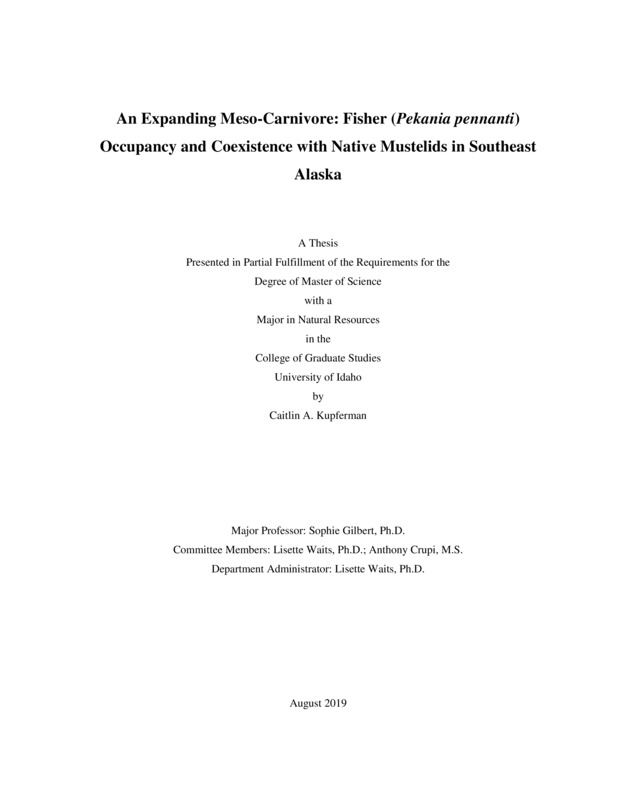An Expanding Meso-Carnivore: Fisher (Pekania pennanti) Occupancy and Coexistence with Native Mustelids in Southeast Alaska
Kupferman, Caitlin. (2019-08). An Expanding Meso-Carnivore: Fisher (Pekania pennanti) Occupancy and Coexistence with Native Mustelids in Southeast Alaska. Theses and Dissertations Collection, University of Idaho Library Digital Collections. https://www.lib.uidaho.edu/digital/etd/items/kupferman_idaho_0089n_11624.html
- Title:
- An Expanding Meso-Carnivore: Fisher (Pekania pennanti) Occupancy and Coexistence with Native Mustelids in Southeast Alaska
- Author:
- Kupferman, Caitlin
- Date:
- 2019-08
- Keywords:
- alaska competition ermine fisher marten occupancy
- Program:
- Natural Resources
- Subject Category:
- Wildlife conservation
- Abstract:
-
Around the world, species’ distributions are shifting in response to climate change, with many species exhibiting range expansion toward the poles. These range expansions often create new species interactions that are not well understood. The fisher (Pekania pennanti) is a mammalian carnivore that has recently expanded its range into the coastal temperate rainforest of Southeast Alaska (SEAK). Little is known about its occupancy and effects on native species in SEAK. The goal of this project was to examine fisher occupancy, density, and co-occurrence with American marten (Martes americana) and ermine (Mustela erminea) in SEAK. Twenty-five paired camera and hair snag stations (50 unique sites) were deployed north of Juneau, Alaska from January−April 2018, resulting in detection of 15 species and collection of 204 hair samples. Polymerase chain reactions conducted on DNA extracted from hair samples showed that 16 of those hair samples were from fisher. From the fisher DNA samples, only one individual fisher was identifiable (a female), making a fisher density analysis unfeasible. However, camera trap data allowed us to conduct single species occupancy analyses at both local and broad scales, which showed that fisher detection was negatively impacted by snow density, but positively affected by whether a fisher had been detected at the previous occasion (average site scale p = 0.24 (95% CI = 0.12, 0.40); average grid scale p = 0.15 (95% CI = 0.07, 0.30)). Fisher occupancy was positively impacted by snow density at the local scale and positively associated with vegetation height at a broader scale (average site scale psi = 0.30 (95% CI = 0.08, 0.72); average grid scale psi = 0.40 (95% CI = 0.003, 0.83)). Although high snow density has the potential to decrease the impact of a fisher’s high foot-load by making it easier to travel on top of the snow, the effect may not be powerful enough to overcome the high energetic costs associated with movement in deep snow and therefore not positively contribute to detectability on a day-to-day basis. The slight positive correlation between snow depth and snow density in our analysis may corroborate this (r = 0.43). Among mustelid species, top models from two-species occupancy analyses indicated that fisher have no effect on marten or ermine occupancy, although there was slight support for the model indicating that fisher may negatively impact marten occupancy. Analysis of diel activity patterns and temporal overlap indicated that marten and ermine adjust their activity patterns in the presence of fisher, potentially to reduce overlap. Furthermore, ermine displayed temporal avoidance of marten, whereas marten activity was unaffected by ermine presence. A small fisher sample size made it unfeasible to examine shifts in fisher activity patterns in the presence of marten and ermine. These results show that mustelids in SEAK currently co-exist through temporal partitioning, with smaller-bodied mustelids avoiding larger, more dominant mustelids. However, if the fisher population continues to expand, these species interactions may shift and increase the potential for competition between fisher, marten, and ermine in SEAK. Overall, this research indicates that fisher, including a female, currently occupy the study area and prefer areas with taller trees and higher snow density, indicating that other areas of Southeast Alaska may be suitable fisher habitat. This study’s methodology was unable to measure fisher density, but was able to identify important predictive covariates associated with fisher occupancy in SEAK, and illustrate temporal partitioning patterns among mustelid species in the area. Future research to increase sample size and detect species’ trends in SEAK over time will be beneficial, but this pilot research was an important first step in developing a monitoring protocol and management plan for fisher in SEAK.
- Description:
- masters, M.S., Natural Resources -- University of Idaho - College of Graduate Studies, 2019-08
- Major Professor:
- Gilbert, Sophie
- Committee:
- Waits, Lisette; Crupi, Anthony
- Defense Date:
- 2019-08
- Identifier:
- Kupferman_idaho_0089N_11624
- Type:
- Text
- Format Original:
- Format:
- application/pdf
- Rights:
- In Copyright - Educational Use Permitted. For more information, please contact University of Idaho Library Special Collections and Archives Department at libspec@uidaho.edu.
- Standardized Rights:
- http://rightsstatements.org/vocab/InC-EDU/1.0/

